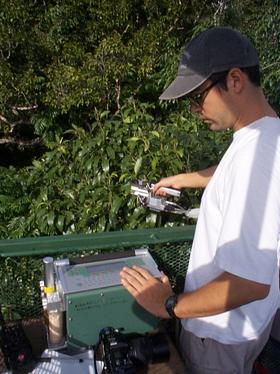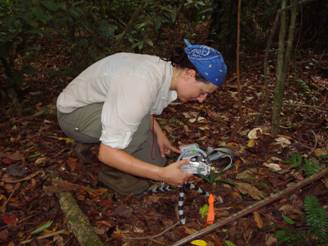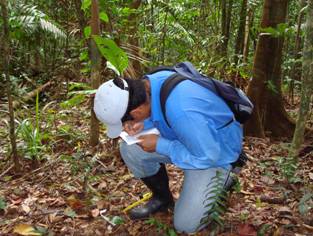Ecology and Evolution of Plant Physiological Processes
Eco-physiology research in the Santiago Lab concerns the economics of leaf-level carbon gain in plants with regard to (1) understanding how photosynthesis is regulated by plant hydraulic processes, (2) determining which nutrients limit photosynthetic processes and understanding the nature of nutrient limitation, and (3) predicting the responses of woody plant species to environmental change.

Hydraulic Regulation of Plant Carbon Gain
Water availability can limit plant carbon gain even in the wettest environments. Therefore research in this lab has focused on the relationship between plant hydraulic features, such as hydraulic conductivity, hydraulic architecture, and stomatal regulation, and the ability of plants to photosynthesize. We have found that among tree species growing in the canopy of tropical forest in Panama, there is a strong relationship between photosynthetic capacity and hydraulic conductivity.
Nutrient Limitation of Physiological Processes

Plant macronutrients are nitrogen (N), phosphorus (P) and potassium (K), and have a large potential to affect the ability of plants to photosynthesize. We are currently studying the effects of nutrient availability on plant physiology in a long-term fertilization experiment in mature lowland tropical forest in Panama in collaboration with Joseph Wright of the Smithsonian Tropical Research Institute.

This fertilization study began in 1998 and allows us to determine which nutrients limit physiological processes, and how nutrients may limit the responses of plants to climate change or increasing [CO2]
Predicting Plant Responses to Environmental Change
Recent drought-induced tree mortality has now been documented in forests worldwide. With global change, pronounced shifts in rainfall patterns, as well as increased frequency and severity of extreme droughts, are projected. However, within any ecosystem, there may be many species that respond differently to drought, making it generally difficult to predict how environmental change will affect an ecosystem. Our work focuses on understanding physiological differences among diverse groups of plant species so that we can predict how individual species may respond to potential changes in rainfall, temperature, atmospheric composition, or drought frequency and severity.

Tropical forests harbor the greatest biodiversity, productivity and terrestrial carbon stocks of any biome and thus play a disproportionately large role in the global climate system. Even in moist and wet tropical forests, tree mortality associated with drought occurs. However, the processes leading to drought-induced mortality of trees in general, and especially of tropical trees, needs more work. In fact, the largest gaps in our ability to predict how tropical forests will respond to climate change are associated with plant physiological processes. Therefore, we measure variation in drought resistance among species and use climatic modeling simulations to project the consequences of drought on the function of tropical forests.
Predicted changes in precipitation are expected to have large effects on southern California ecosystems. Desert Chaparral is a transitional vegetation type that occurs at the intersection of the Deserts of the Southwest and the California Floristic Province. This botanical boundary has deep paleontological roots. It is here that chaparral shrubs occur with elements from upslope evergreen woodland and downslope Mojave Desert components, producing an ecosystem of considerable floristic complexity. Our goal in the Desert Chaparral is to predict which shrub species in desert chaparral are most susceptible to mortality by drought and how their potential disappearance could affect water cycling by plants. The central hypothesis is that drought resistance among shrub species is a product of tradeoffs between rooting depth, phenology, and vulnerability of the xylem to cavitation. Sorting out the physiological tradeoffs that determine the drought resistance strategies of species will increase our ability to predict which species are most susceptible to local mortality by drought, and allow us to construct realistic models of species composition change in order to forecast how changes in water cycling by plants may change with alteration of vegetation communities.